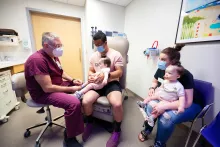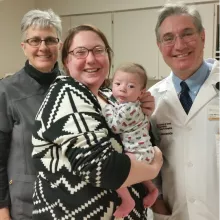The University of Iowa is the home of modern treatment for clubfoot. The late Ignacio Ponseti, MD, developed the Ponseti method for clubfoot treatment, which has been accepted world-wide.
When treated by expert hands practicing the Ponseti method, infants born with clubfeet will have normal looking feet with normal function. The well-treated clubfoot is no handicap and the child is fully capable of living a normal, active life.
In the majority of cases, clubfeet can be corrected in infancy in about six to eight weeks with proper gentle manipulations and plaster casts. The treatment is based on understanding of the functional anatomy of the foot and of the biological response of muscles, ligaments and bone to corrective position changes gradually obtained by manipulation and casting.
The treatment should begin in the first week or two of life to take advantage of the elasticity of the tissues forming the ligaments joint capsules and tendons. A plaster cast is applied after each weekly session to retain the degree of correction obtained and to soften the ligaments. The misplaced bones are gradually brought into the correct alignment.
Five to seven plaster casts extending from the toes to the upper thigh with the knees at right angle are usually sufficient to correct the clubfoot deformity. Even very stiff feet require no more than eight or nine plaster casts to obtain maximum correction.
Before applying the final plaster cast, which is worn for three weeks, the Achilles tendon is often cut to complete the correction of the foot. By the time the cast is removed the tendon has regenerated to a proper length.
To prevent relapses, when the last plaster cast is removed, a brace must be worn full-time for two to three months and thereafter at night for approximately four to five years.
Our Care Team

- Department of Pediatrics
- Orthopedics and Rehabilitation

Not sure which Clubfoot provider is right for you?
Locations and Offices

Related Health Topics
Patient Stories


Related News
